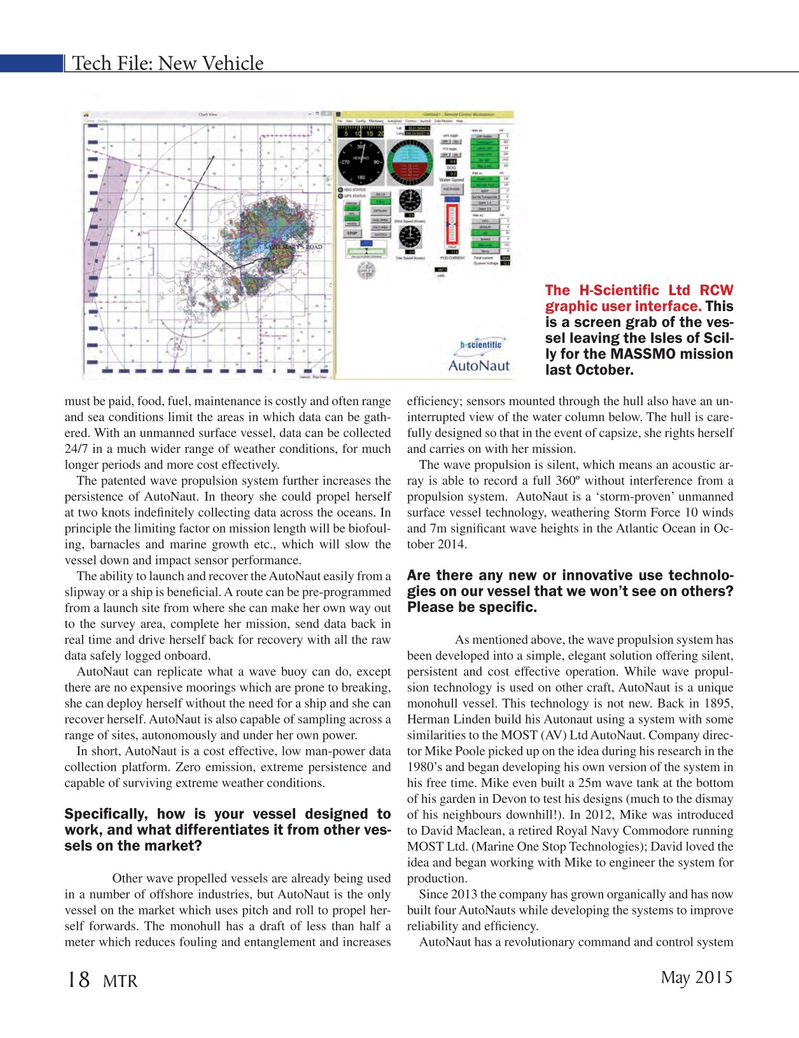
Page 18: of Marine Technology Magazine (May 2015)
Underwater Defense
Read this page in Pdf, Flash or Html5 edition of May 2015 Marine Technology Magazine
Tech File: New Vehicle
The H-Scienti? c Ltd RCW graphic user interface. This is a screen grab of the ves- sel leaving the Isles of Scil- ly for the MASSMO mission last October.
must be paid, food, fuel, maintenance is costly and often range ef? ciency; sensors mounted through the hull also have an un- and sea conditions limit the areas in which data can be gath- interrupted view of the water column below. The hull is care- ered. With an unmanned surface vessel, data can be collected fully designed so that in the event of capsize, she rights herself 24/7 in a much wider range of weather conditions, for much and carries on with her mission. longer periods and more cost effectively. The wave propulsion is silent, which means an acoustic ar-
The patented wave propulsion system further increases the ray is able to record a full 360º without interference from a persistence of AutoNaut. In theory she could propel herself propulsion system. AutoNaut is a ‘storm-proven’ unmanned at two knots inde? nitely collecting data across the oceans. In surface vessel technology, weathering Storm Force 10 winds principle the limiting factor on mission length will be biofoul- and 7m signi? cant wave heights in the Atlantic Ocean in Oc- ing, barnacles and marine growth etc., which will slow the tober 2014. vessel down and impact sensor performance.
The ability to launch and recover the AutoNaut easily from a
Are there any new or innovative use technolo- slipway or a ship is bene? cial. A route can be pre-programmed gies on our vessel that we won’t see on others? from a launch site from where she can make her own way out
Please be speci? c.
to the survey area, complete her mission, send data back in real time and drive herself back for recovery with all the raw As mentioned above, the wave propulsion system has data safely logged onboard. been developed into a simple, elegant solution offering silent,
AutoNaut can replicate what a wave buoy can do, except persistent and cost effective operation. While wave propul- there are no expensive moorings which are prone to breaking, sion technology is used on other craft, AutoNaut is a unique she can deploy herself without the need for a ship and she can monohull vessel. This technology is not new. Back in 1895, recover herself. AutoNaut is also capable of sampling across a Herman Linden build his Autonaut using a system with some range of sites, autonomously and under her own power. similarities to the MOST (AV) Ltd AutoNaut. Company direc-
In short, AutoNaut is a cost effective, low man-power data tor Mike Poole picked up on the idea during his research in the collection platform. Zero emission, extreme persistence and 1980’s and began developing his own version of the system in capable of surviving extreme weather conditions. his free time. Mike even built a 25m wave tank at the bottom of his garden in Devon to test his designs (much to the dismay
Speci? cally, how is your vessel designed to of his neighbours downhill!). In 2012, Mike was introduced work, and what differentiates it from other ves- to David Maclean, a retired Royal Navy Commodore running sels on the market?
MOST Ltd. (Marine One Stop Technologies); David loved the idea and began working with Mike to engineer the system for Other wave propelled vessels are already being used production. in a number of offshore industries, but AutoNaut is the only Since 2013 the company has grown organically and has now vessel on the market which uses pitch and roll to propel her- built four AutoNauts while developing the systems to improve self forwards. The monohull has a draft of less than half a reliability and ef? ciency. meter which reduces fouling and entanglement and increases AutoNaut has a revolutionary command and control system
May 2015 18 MTR
MTR #4 (18-33).indd 18 MTR #4 (18-33).indd 18 4/29/2015 9:50:30 AM4/29/2015 9:50:30 AM

 17
17

 19
19
